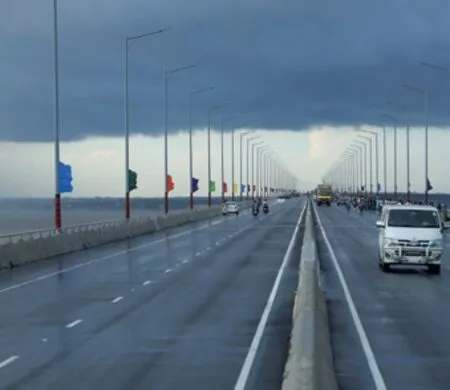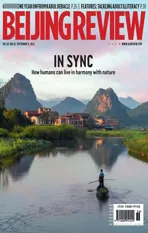Bridge of Dreams
2022-09-06BangladeshidoctorworkstobuildplatformforhealthcooperationByMaMiaomiao
A Bangladeshi doctor works to build a platform for health cooperation By Ma Miaomiao
The 6.15-km Padma Bridge that opened to traffic on June 25 in Munshiganj District of central Bangladesh is a bridge of dreams to many locals. Known as the largest and most challenging infrastructure project in Bangladeshi history and undertaken by the China Railway Major Bridge Engineering Group Co., it has brought to an end the necessity of using boats and ferries to cross the mighty Padma river, which flows through dozens of districts in south Bangladesh.
The achievement has also excited Misbahul Ferdous, a 39-year-old Bangladeshi doctor living and working in China, and, more importantly, driven him to devote more energy to his own “bridge:”a virtual one of healthcare collaboration.
What Ferdous wishes to achieve sounds simple but may be more challenging, that is to connect people in all developing countries and provide them with good healthcare facilities, technologies and services. What he is using to try to bring that to fruition is the cooperation framework under the Belt and Road Initiative, a China-proposed initiative to boost connectivity along and beyond the ancient Silk Road routes.
Raising concerns
Ferdous is a doctor at Beijing’s Fuwai Hospital,an affiliate of the Chinese Academy of Medical Sciences, also known as the National Center for Cardiovascular Diseases. He is working on addressing concerns about people with post-COVID-19 conditions.
Post-acute sequelae of COVID-19 refers to the long-term effects experienced by some people who have been infected with the coronavirus. The World Health Organization defines it as symptoms that last 12 weeks or longer.
“Even when cured after 14 or 21 days, some patients may still have symptoms that continue for at least the next 10 years,” Ferdous told, adding the global health corridor he proposed aims to reduce COVID-19-related complications in those participating countries, promote exchanges on treatment protocols and increaseCOVID-19-related health facilities in these countries.

Vehicles cross the Padma Bridge in Munshiganj,Bangladesh, on June 26
The proposal also recommends hosting academic discussions, training young doctors, establishing more telemedicine services and setting up a COVID-19 clinical data cloud system for hospitals in countries participating in Belt and Road cooperation.
“I believe global health needs joint efforts with many countries working together and making all the organizations cooperate in one platform,” Ferdous said.To him, the initiative provides a platform to improve capacity for handling regional public health emergencies through information sharing.

Misbahul Ferdous,a Bangladeshi doctor at Beijing’s Fuwai Hospital
“What I saw during this pandemic was that the world wasn’t well united,” Ferdous said, adding his purpose was to gain an understanding of more people’s concerns on this issue and make a start.“I know I alone can’t achieve this. But we must start doing it. And once we’ve started, I think many people will join.”
So far, more than 30 hospitals in 10 countries have expressed interest in taking part in his project,he said.
Living in China
Coming to China for further study in the field of medicine in September 2009, Ferdous was the first Ph.D. student in medicine from Bangladesh to graduate from Shandong University in Jinan,Shandong Province. Recalling how he made the decision to come to China, he said it was, at the outset, a random pick, but became the best choice he had ever made.
After graduation in 2017, he joined Fuwai Hospital a year later. His mentor, Wu Yongjian, is one of the top cardiologists in Asia.
The Belt and Road Initiative wasn’t a novelty for Ferdous. He and Wu have long shared similar endeavors to improve medical services along the Belt and Road routes. “In many people’s minds, the initiative only means bridges, roads, infrastructure,finance, etc. They’ve never thought that it could be a driving force for cooperation in the health sector,”he said.
Wu initiated the Belt and Road Chronic Total Occlusion project in 2016, aiming to provide exchange opportunities in cardiology for doctors at Fuwai Hospital and their counterparts worldwide,those from Belt and Road participating countries in particular.
Fuwai Hospital has signed agreements with several foreign medical institutions regarding joint research on heart-related diseases since 2018. In the following years, Wu’s team conducted academic exchanges and training in and with countries including Bangladesh, Malaysia and Indonesia.Young doctors in these countries, especially those in underdeveloped regions, had prior access to the projects. “Whenever they have questions, they can discuss them with us directly,” Ferdous said.
The young doctors can also come to China to receive training at Fuwai Yunnan Cardiovascular Hospital in Kunming, Yunnan Province, and Fuwai Hospital for up to seven months.
Even during the pandemic, the Fuwai team has maintained close and frequent online exchanges with foreign doctors. “In the past two years, we held more than 15 online meetings and two on-site surgical operation training sessions with our counterparts from countries and regions along the Belt and Road routes,” Ferdous said.
In 2020, Ferdous received a Belt and Road Friendship Award, jointly given by the Chinese Cardiovascular Association and other organizations, for his support to China and other countries during the most pressing phase of the pandemic.
In March, Sheng Qiuping, Assistant Minister of Commerce of China, said at a press conference that China’s international development cooperation will focus more on fields such as agriculture, poverty reduction, sanitation and health, and prioritize the construction of more “small and beautiful” projects to enhance the sense of gain among people in host countries.
According to Ferdous, many stories told about the Belt and Road Initiative mainly focus on those mega projects, but the lesser known cooperation in the health sector is actually also welcoming and touching.
With long days of surgery, meetings and administration, it’s coffee, passion, support from his family, and a deep understanding of the importance of his work that keep Ferdous going as he pursues his global goal. “I feel sorry for my wife sometimes as I put a huge burden on her to take care of the family when I am absent... But I do share more household duties during weekends and holidays,”he said.
Building the Padma Bridge took eight years,but how long will it take for Ferdous to achieve his dream? However long, the results will be worth the wait. BR
